To create a new article:
- Navigate to the category where you want to create the article.
- Select + Add Article.
- Enter a title for your article in the Article Title field.
- Select how you want to create the article. Some of these trigger further steps. The options are:
- New article from scratch
- Create from template: when you select this, KnowledgeOwl displays the Choose a Template Article dropdown. This lists all articles that are set as templates. Select the template you want to use. This creates a one-off copy of the template. There is no ongoing link between the template and the new article, so updates to the template do not affect the article.
- Copy from existing: when you select this, KnowledgeOwl displays options to browse for an article by title, in any of your knowledge bases. Select a knowledge base, then start typing the title of the article you want to copy.
- Share content from an existing article: the steps for this are similar to copying from an existing article. However, we recommend following the detailed instructions in the Share articles between categories and knowledge bases section, to ensure you know exactly how the content syncing works.
- Select Add and Edit to create the article and open the editor.
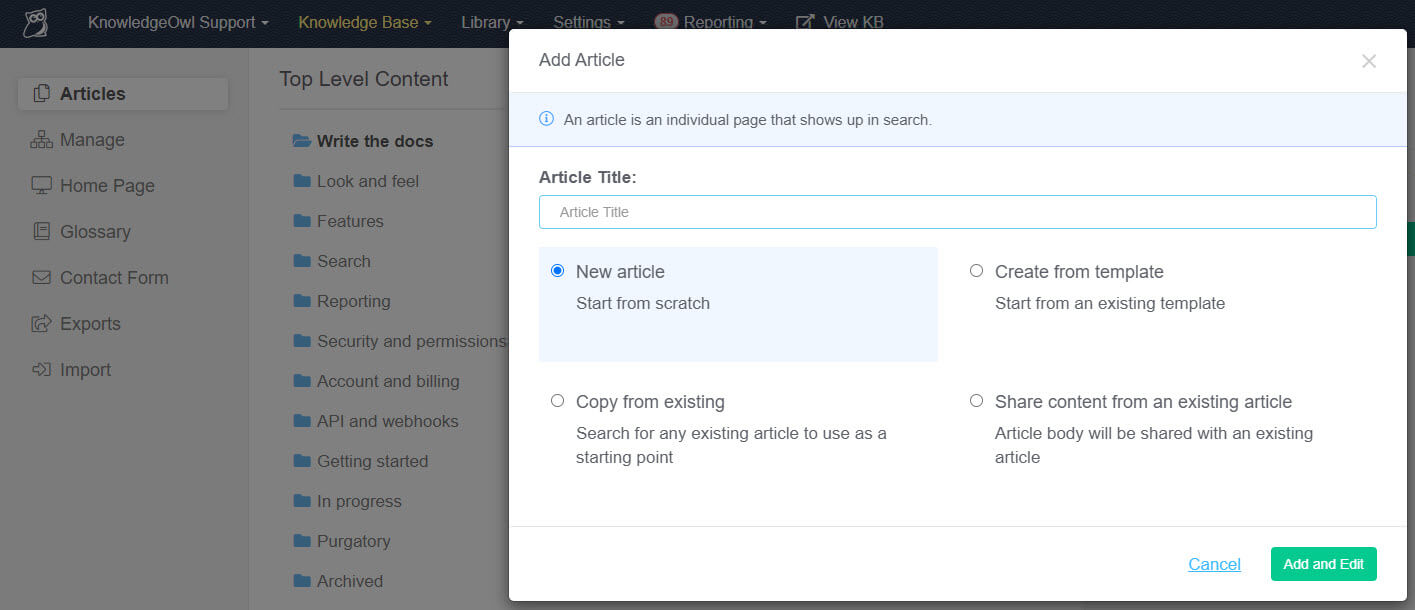
Select this option during article creation to begin with a blank article.
Refer to the Article creation guide for step-by-step instructions.
You can mark specific articles as templates in the Reuse Flags section of the editor. When you create a new article from a template, it creates a one-off copy of the template.
There is no ongoing link between the template and the new article, so updates to the template do not affect the article. Refer to the Article creation guide for step-by-step instructions.
Create a new article from template
To create a new article using an existing template:
- Enter a Title for your new article in the New article modal.
- In the Content section, select Create from template.
- Select the template you'd like to use as a starting point in the Select a Template dropdown.
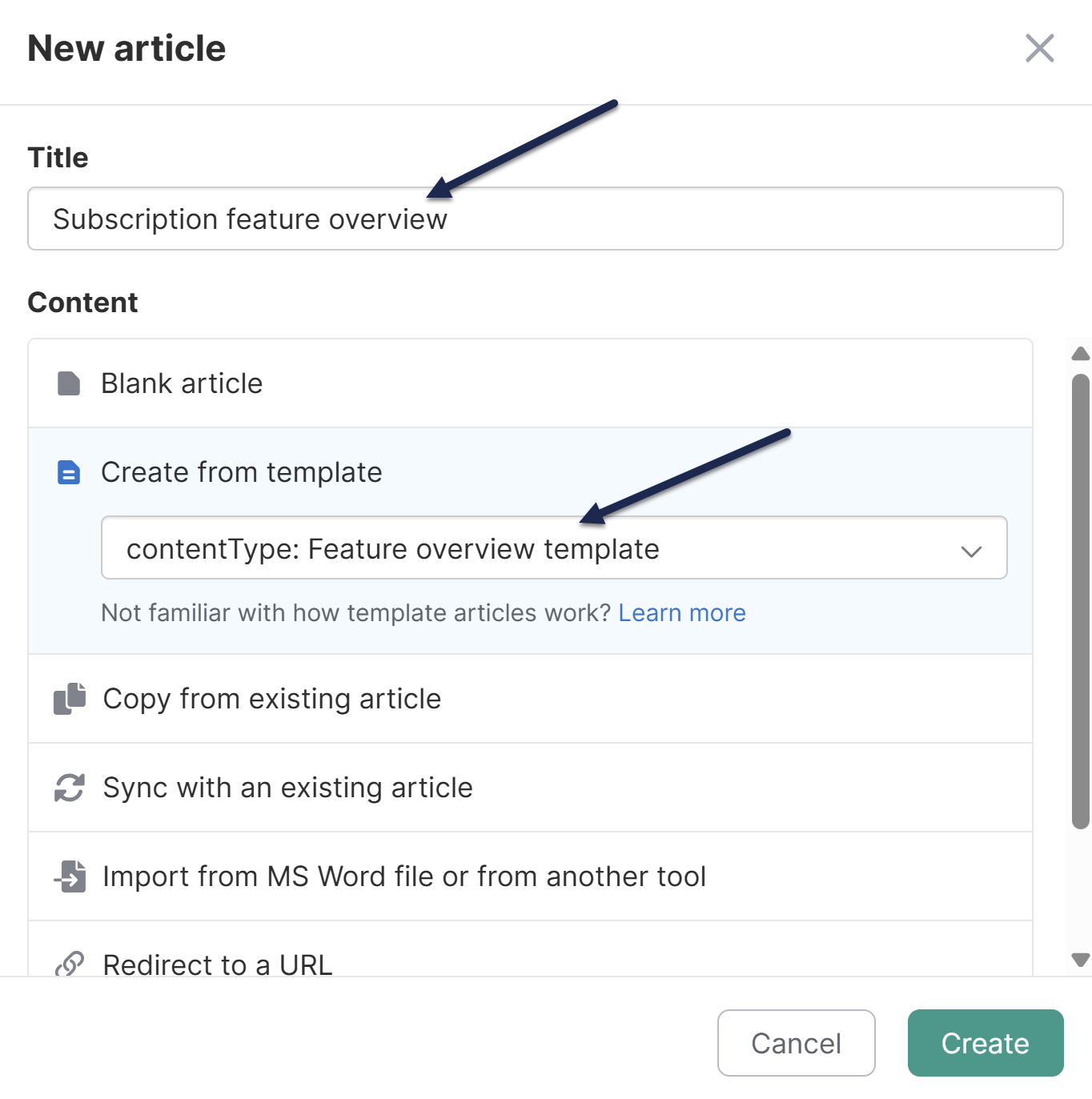
- Select Create.
The article editor opens with the content of the template copied into it. This is a one-off copy. Make the edits you'd like to the article.
Refer to the Article creation guide for more details.
Create a template from an article
Follow these steps to turn any article into a template:
- Open the article for editing.
- In the Reuse Flags section of the righthand column, check the box for Template Article.
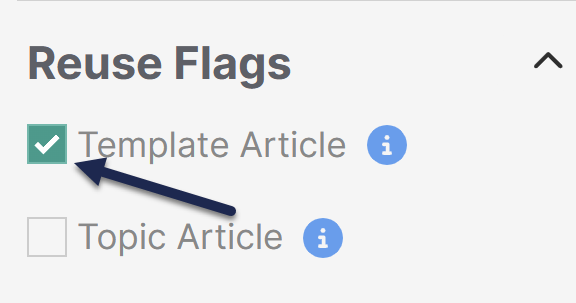 The Template Article checkbox is in the Reuse Flags section of the editor's righthand column
The Template Article checkbox is in the Reuse Flags section of the editor's righthand column - Be sure to Save your changes.
The article will now be available in the Select a Template dropdown of the New article modal when you select Create from template.
This is a sample template for providing style and structure guidance. Refer to Create from template for information on creating articles using templates. You could create a template article with a setup similar to this sample, in order to provide guidance to your writers.
When thinking about what to include in your template, consider using a style guide.
Heading 2: Major topic
Body paragraph. Anything not in a list should be formatted like this. References to specific menu/navigation options should be capitalized, e.g.: Click on Settings > Style. In general, avoid using italics. Use bold only when it feels necessary.
Heading 3: Subheading for Heading 2
Heading 4: You should really consider restructuring your content and breaking it up
Numbered Lists:
- Always use numbered lists for step-by-step instructions.
- Step 1. Each step should be a single, clear step in the process.
- Screenshots should be included in the list item so that they are properly indented. Include arrows or callouts using branded color palette. Use rounded square for shape call-outs.

- Sample code should be included in the list item so that it is properly indented:
<a href="#">Here's some sample code in just preformatted style</a>
Bullet point lists:
- Always use bullet point lists for lists rather than instructions
- Think carefully about list length. Longer lists are harder to process; it's recommended to keep bulleted lists to about seven items. Read more about making your content brain friendly.
- Good use of bold: when you have a bullet point list with items that also have descriptions
- Keep your list consistent; list items should either all end in periods or should have no periods
- Screenshots relevant to the list should be within the bulleted list item:
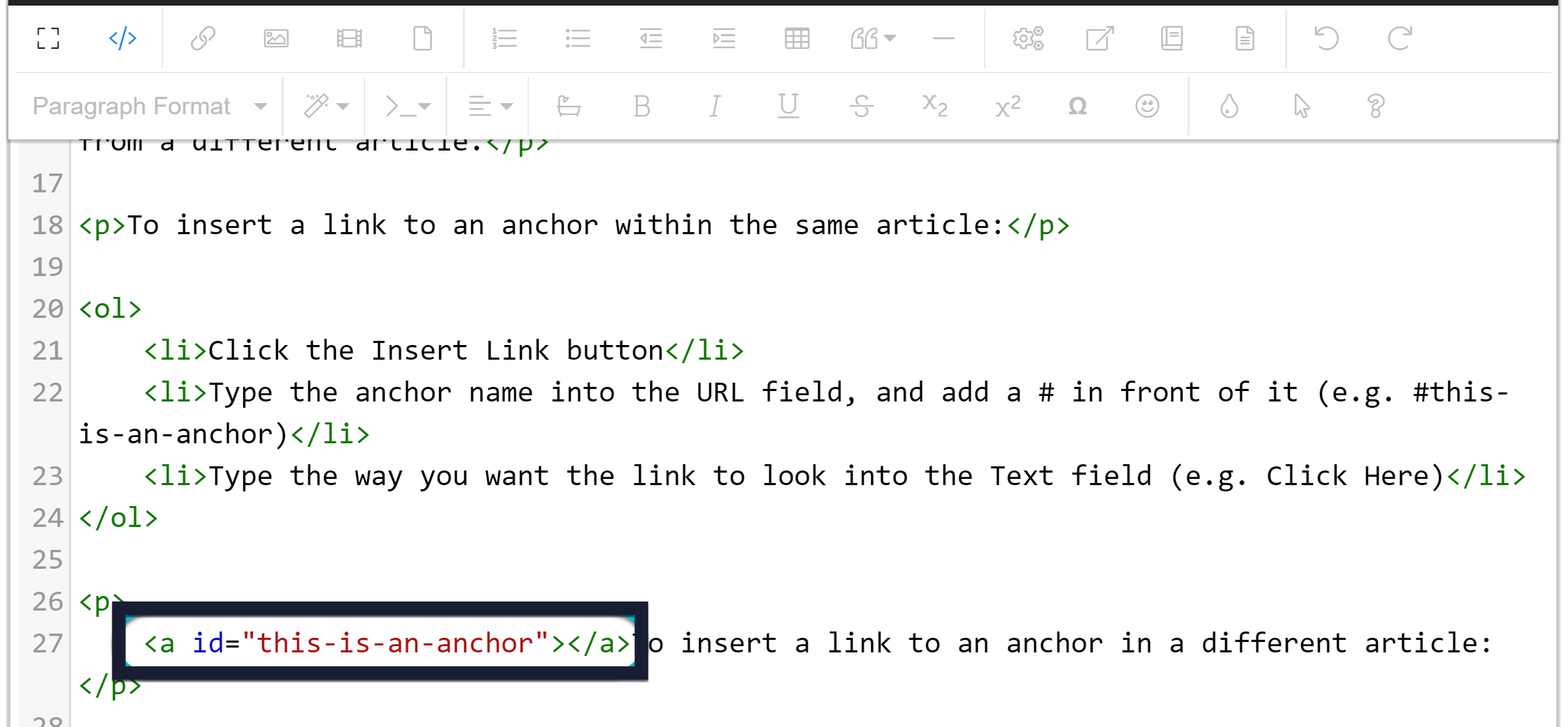
Pro Tip: Use Alert Success for things that could be classified as tips or "Pro Tips". These look better if they start with a bolded phrase.
Note: Use Alert Info for useful notes and asides. These aren't tips; they're a note or point that you want to call attention to.
Warning: Use Alert Danger for things that are destructive, permanent, or otherwise dangerous. If making a change or not following this step is going to cause disaster and chaos, tell people!
You can copy an existing article from any of your knowledge bases, to use as a starting point for your article. Unlike the shared content article, copying an article does not create a link between the two articles. Any changes you make in the new article will not affect the old article.
Refer to the Article creation guide for step-by-step instructions.
You can use a single article in multiple categories and across knowledge bases. The content (body) of the article as well as all versions stay in sync across all shared articles. Each article can have its own title, restrictions, and callouts. These are called shared content articles.
Updating the content of any of the articles updates the content of all of them.
To share an existing article in another category or knowledge base:
- On the Articles page, navigate to the location where you wish to add the article.
- Select + Add Article.
- Select Share content from an existing article.
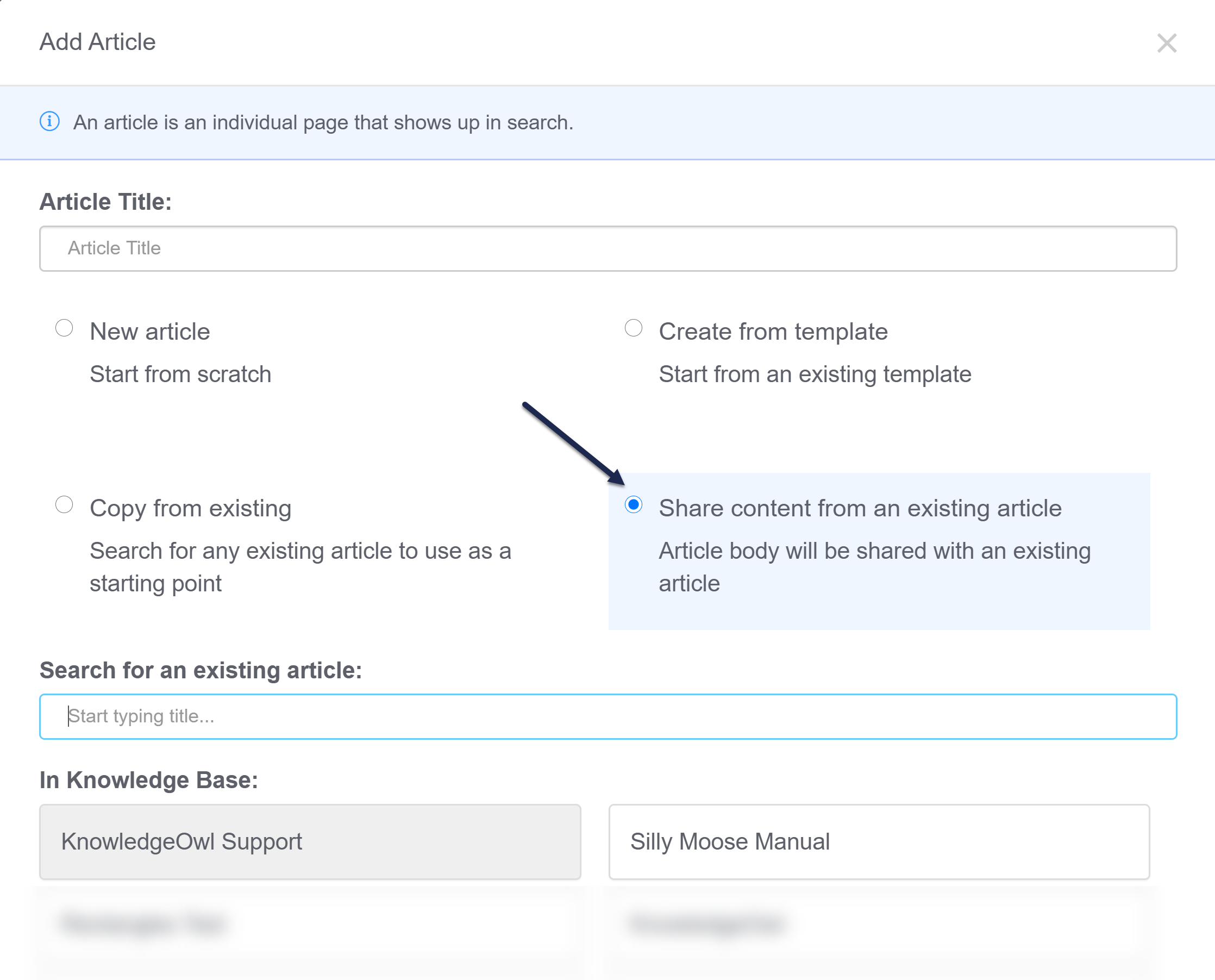
- Additional options appear below. If you have multiple knowledge bases, the knowledge base you're currently in is selected, but you can select a different knowledge base's articles to search.
- Next, in the Search for existing article field, start typing part of the article's name. This is an exact match search, and the dropdown will offer you articles that match your search.
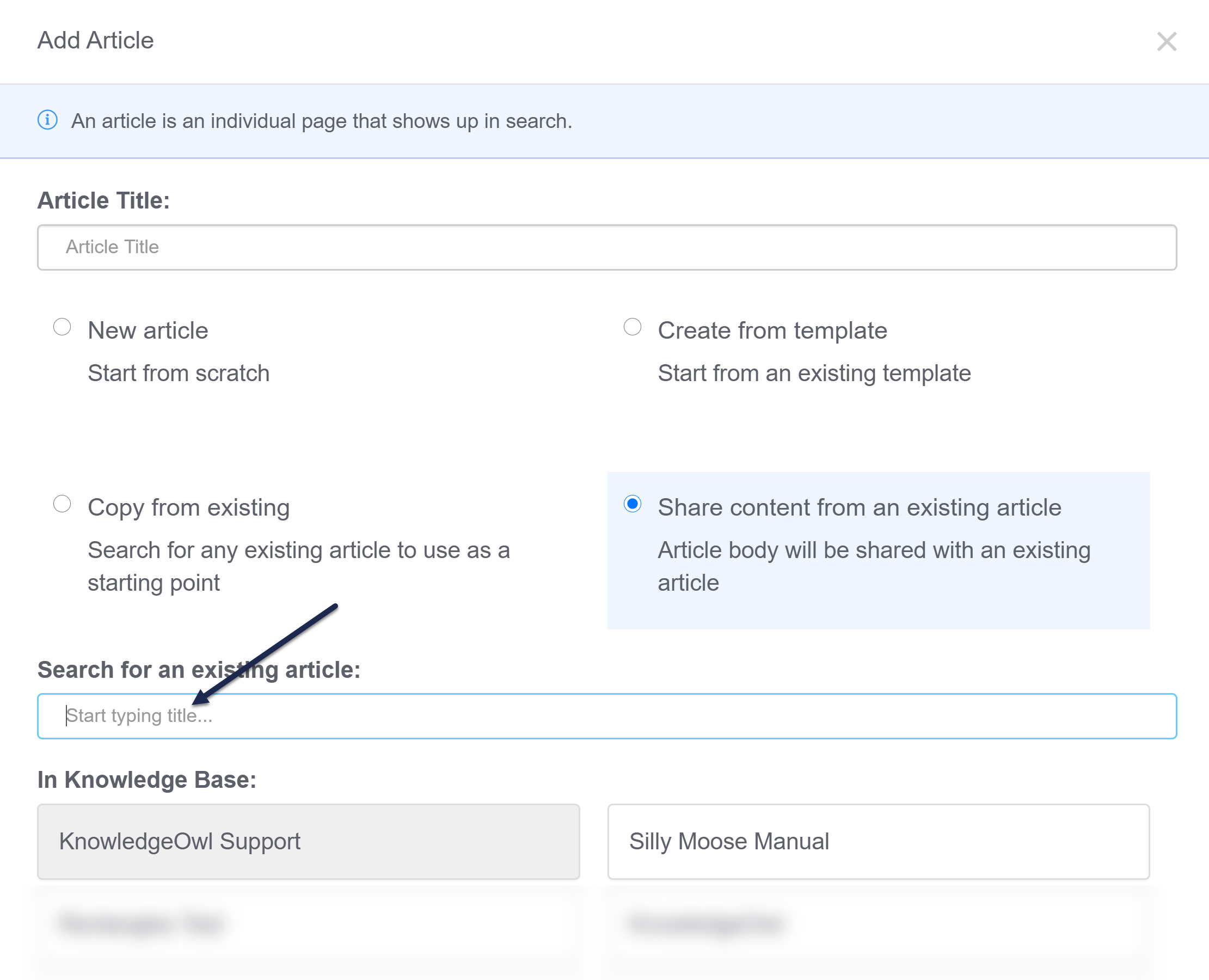
- Once the article you wish to share content with appears, select it.
- This will copy the Article Title field at the top, based on the shared content article's title. You can change this if you wish.
- Once you're done selecting the article and editing the title (if needed), click the Add and Edit button in the lower right to complete the content sharing.
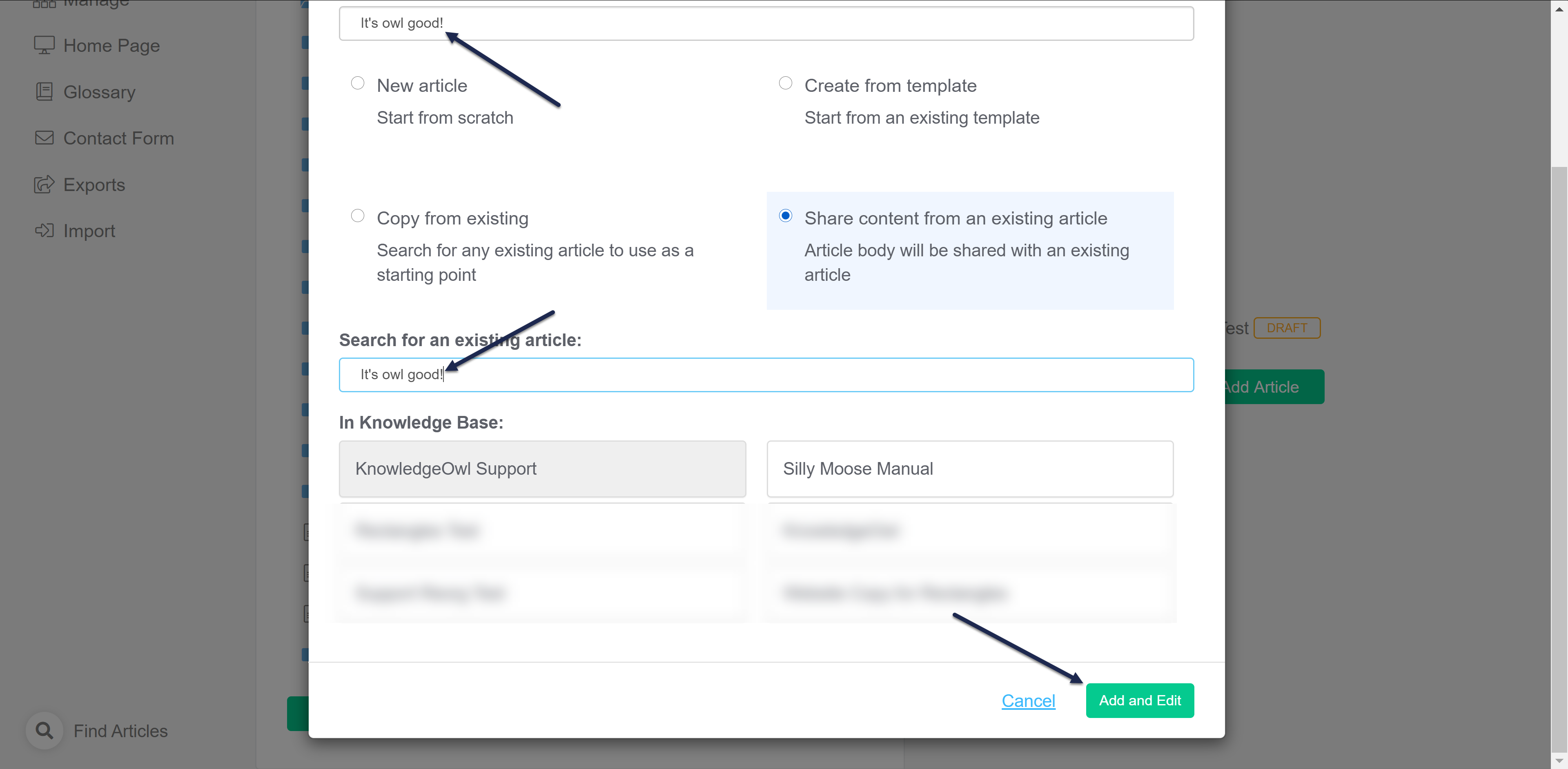
- This will open the new, shared content article. It will have all the content of the article you selected when you created it. It will open in Draft mode and will have a banner reminding you that this content is linked to an article in another location. Use the links in this banner to quickly navigate to the synced content article or the knowledge base where this is located.
 Sample warning message for a child shared content article
Sample warning message for a child shared content article
- You are now free to make any other changes as necessary to the article. Remember that any changes to the article body will be updated in all shared content articles.
For information on what gets shared and how, see Shared content articles.
Stuck with writer's block? Use OpenAI to generate a rough draft or outline for a new article!
Prerequisite
An account administrator must enable Linus Assist before you can use this feature. Right now, Linus Assist is only available to new accounts, but if you'd like to try it in your account, contact us!
How it works
We'll send a very specific prompt based on the information you provide to OpenAI. No other information or content from your knowledge base is sent.
Generate up to 20 articles across all your knowledge bases this way for free or add your own OpenAI key to generate as many as you like. Refer to What is Linus Assist? for more information.
Generate an article
To use this method for article creation:
- On the Articles page, navigate to the location where you wish to add the article.
- Select + Add Article.
- Select Generate content with AI. Additional information about this account generation option displays.
- Select Open AI Assistant. The modal updates to display the Generate article content options.
- Choose whether you want to create a First draft or an Outline in the What would you like to create? section.
- Outline will create sections and headings, along with placeholder text.
- First draft will generate full, detailed content.
- Enter or update the Article Title.
- Finish this sentence "Write an article about..." to enter the subject you want the article to be about.
- Enter up to 500 characters.
- Choose the type of article you'd like to generate from the What type of article is this? dropdown. Refer to Article types below for guidance on which type to select.
- Select your intended audience for the article from the Who is this article for? dropdown.
- Select the tone of voice you want the article written in from the What tone of voice do you want the article written in? dropdown.
- Once you've made your selections, select Generate Content.
- The modal updates to show you the content as OpenAI generates it so you can preview what it looks like:
If you realize you need to make changes to how the output is generated, select Edit Prompt to refine your prompt.
 Sample generated article content preview
Sample generated article content preview
Once you're happy with the results, select Create Article. - The article editor opens with the generated content.
Writer's block?
Use Linus Assist to generate templates or outlines or use some of our team's favorite amusing prompts from Article title prompts for Linus Assist.
Article types
Linus Assist will currently generate one of eight different article types. Here's a bit more information on the format Linus Assist will generate for each type:
- How-to guide: A practical, step-by-step guide to completing a task. Begins with a short summary followed by a list of clear steps.
- Explanation: A conceptual article providing background, rationale, or a deep dive into a topic.
- Reference: A structured, factual description of options, fields, or features. Information should be presented in a consistent format like tables and bullet points.
- Tutorial: A beginner-friendly, end-to-end walkthrough for learning something new. Begins with context and prerequisites, details the walkthrough, and then provides next steps.
- Policy: A formal rule or guideline using clear, declarative statements.
- Procedure: A standardized, internal process described in clear, ordered, numbered steps.
- FAQ: Generates a Frequently Asked Questions (FAQ) format with clear questions and comprehensive answers.
- KCS knowledge article: A real-world, question-driven article that documents an issue, environment, and resolution. Should Include sections for Issue, Environment, Resolution, and Cause (if known), similar to some of the standard KCS knowledge article templates.
What if the content you'd like to include in your knowledge base isn't IN your knowledge base? Maybe you'd like to reference the page of another site, or a press packet your PR department has put together.
You can set up both categories and articles as URL redirects. For articles, this means you can administer the article as an article (restrict it to groups, restrict editing to teams, use the article call-outs, assign related articles) but when someone clicks on the title of the article or navigates to the URL, they'll be redirected to the URL you set up, instead.
URL redirects can be great when used with:
- Links to external sites/files you don't want or can't move into KnowledgeOwl
- Links to files stored within KnowledgeOwl, where you want the file to open directly (See the KnowledgeOwl W-9 for an example of this type!)
You can create a new article as a URL redirect or convert an existing article to be a URL redirect. To do so:
- In the URL Redirect section of the righthand menu of the article editor, check the box next to Redirect this article to a different URL.
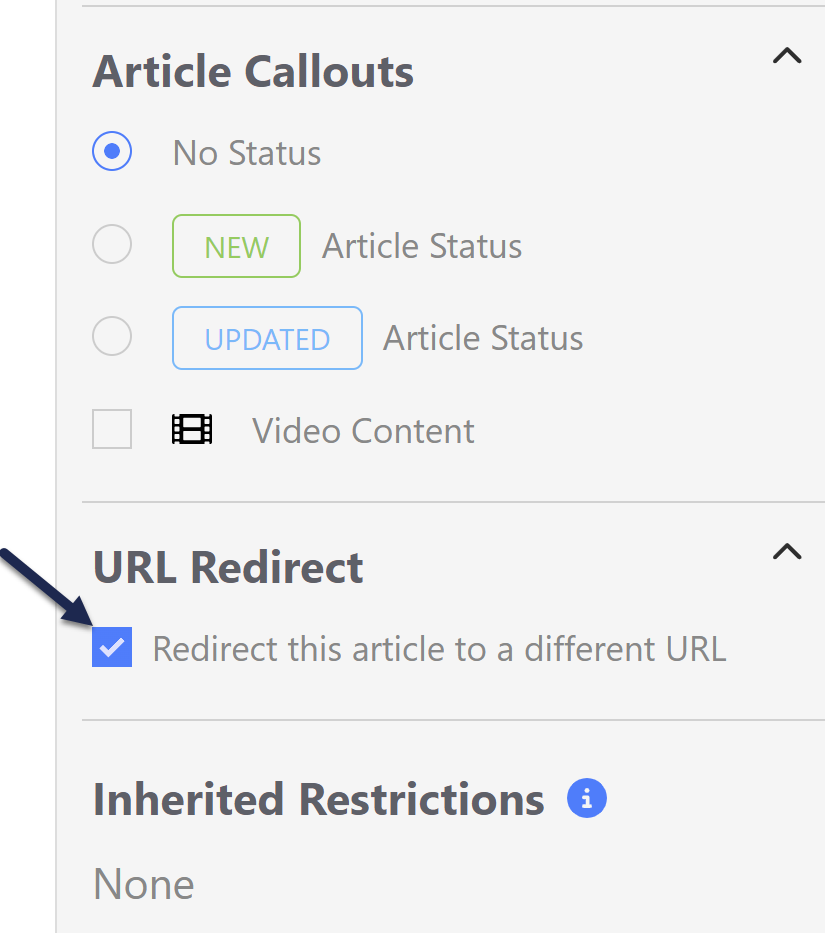 The URL Redirect section is located between Article Callouts and Inherited Restrictions
The URL Redirect section is located between Article Callouts and Inherited Restrictions
- Once checked, this will add a section between the full article title and the editor where you can add the URL you'd like to redirect to:
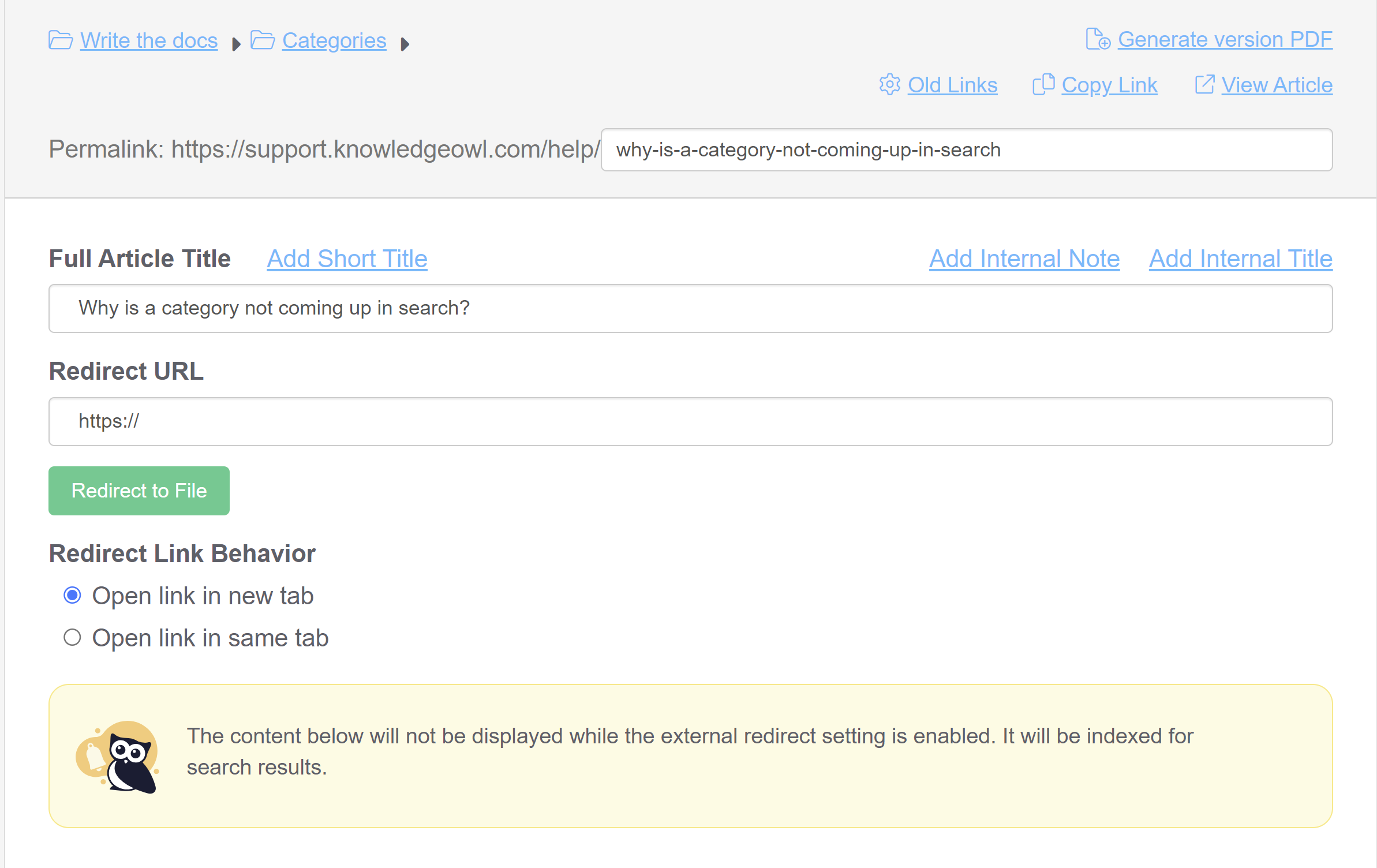
- Now, add the URL you'd like to redirect to.
- For external URLs, type or paste the URL you'd like to use into the Redirect URL field. Here, we're redirecting to the International Owl Center's Owl Glossary page:
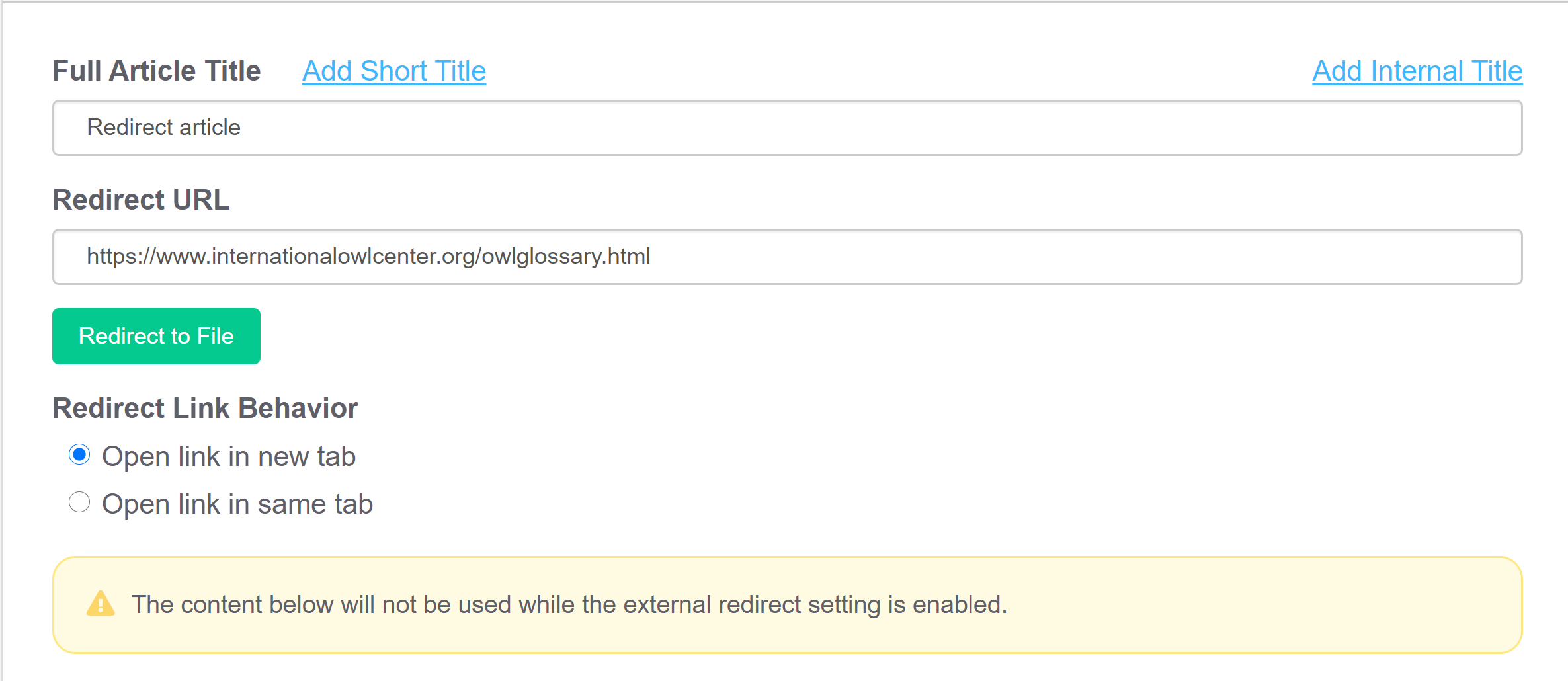 Sample external redirect URL
Sample external redirect URL
- To redirect to a file uploaded to KnowledgeOwl (or to directly upload a file to KnowledgeOwl to redirect to), click the Redirect to File button:
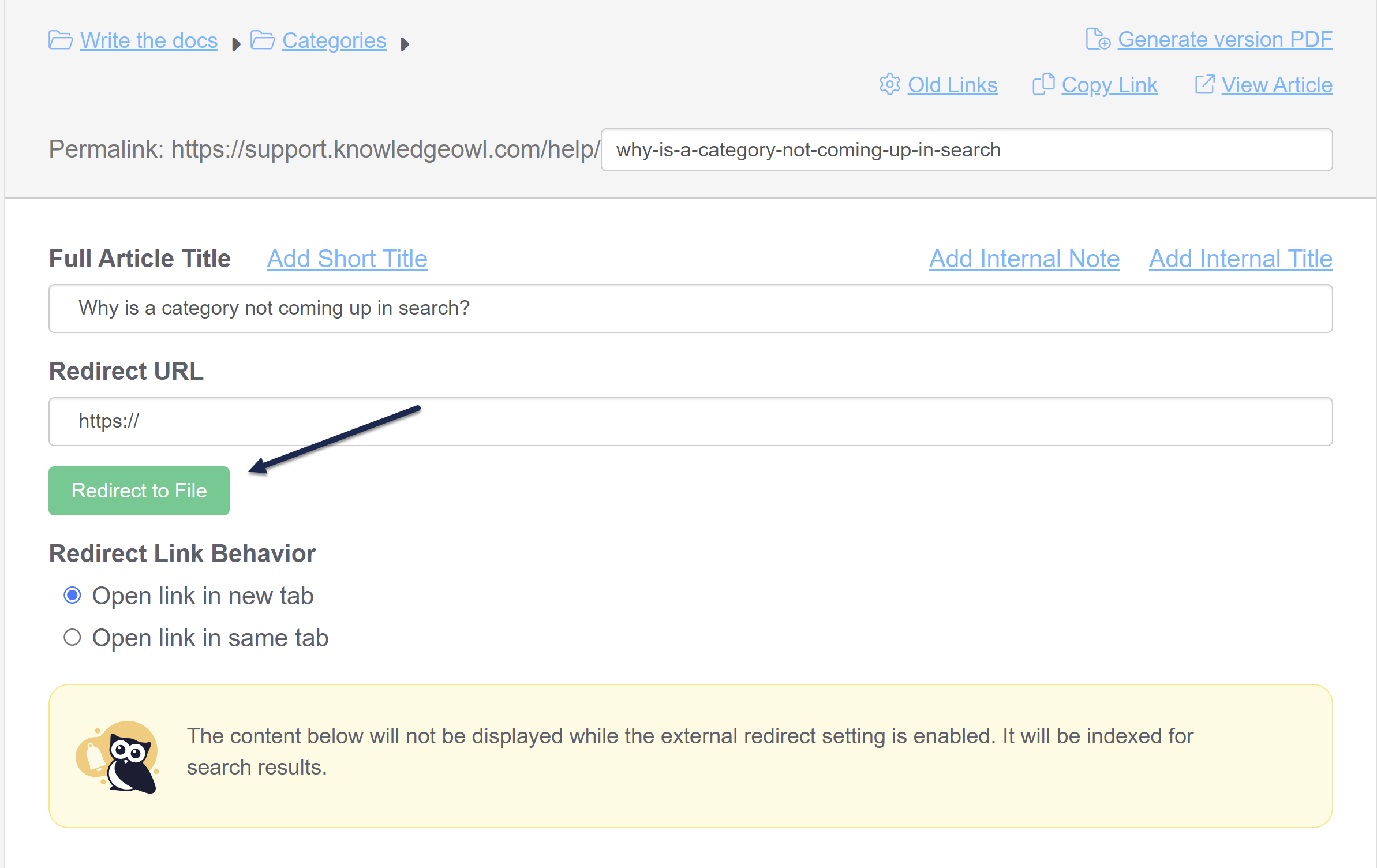 Click the Redirect to File button
Click the Redirect to File button
- This will open an Add file from Library pop-up where you can select the file you'd like to insert. Browse or search for the file. (Or click Upload New File to add a new one.) Click on it to select it, then click the Insert File button in the lower right.
 Select the file you'd like to redirect to and click Insert File
Select the file you'd like to redirect to and click Insert File
- The URL of the file will be added to the Redirect URL field:
 Redirect article with a KO file URL used
Redirect article with a KO file URL used
- This will open an Add file from Library pop-up where you can select the file you'd like to insert. Browse or search for the file. (Or click Upload New File to add a new one.) Click on it to select it, then click the Insert File button in the lower right.
- For external URLs, type or paste the URL you'd like to use into the Redirect URL field. Here, we're redirecting to the International Owl Center's Owl Glossary page:
- Set whether you'd like the redirect link to open in a new tab or in the same tab. (Open link in new tab is used by default.)
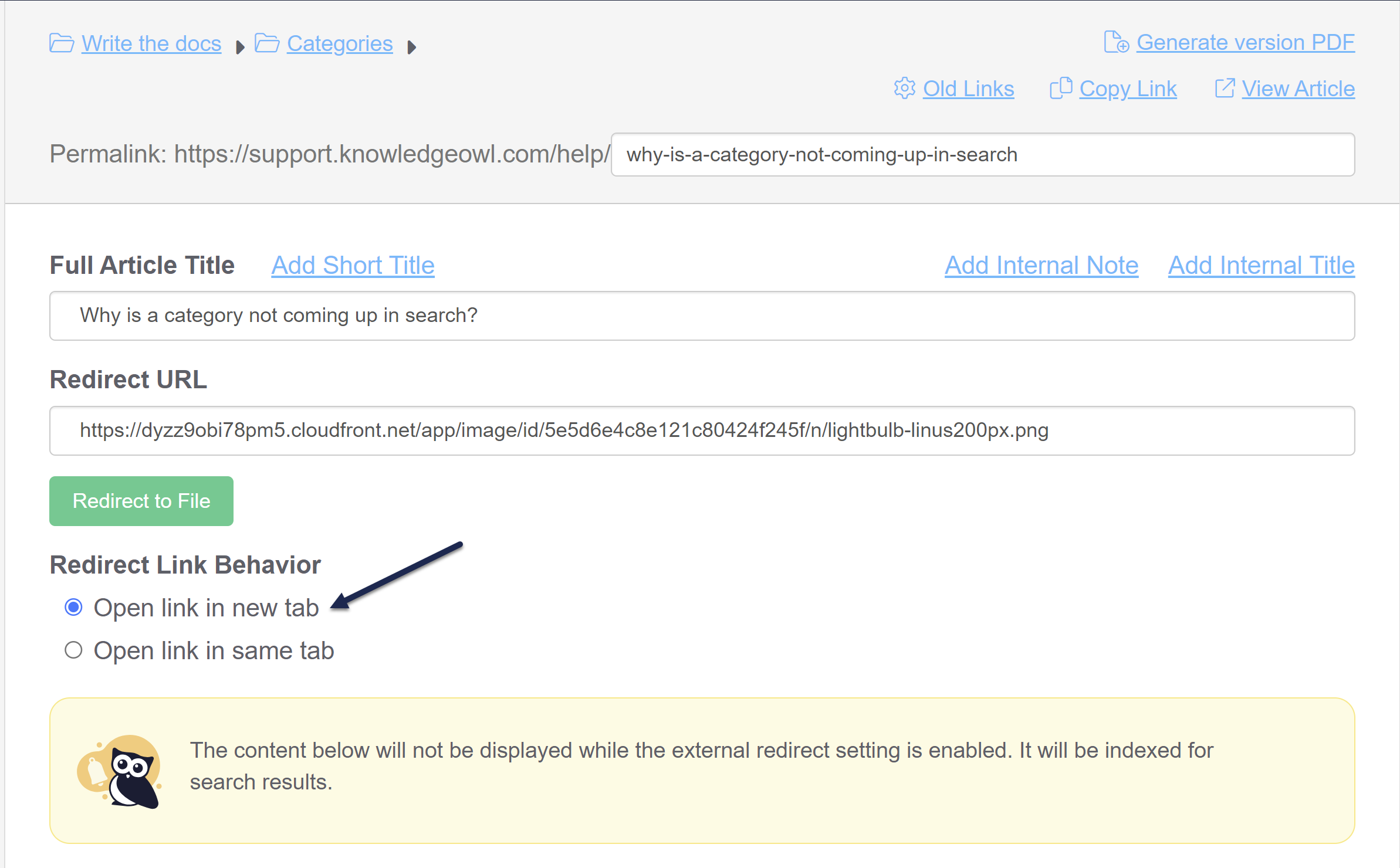
- Save your article.
To switch an article from being a URL redirect to being a normal article, uncheck the "Redirect this article to a different URL" box. Once you save, the article will function normally and display whatever content is in the editor.
Anything included in the body of the article will still be indexed for search even though it won't be displayed. You can use this to your advantage to help provide additional words or terminology to help people find this article!
For example, if you're using a file stored within KnowledgeOwl, the content of that URL redirect file will not automatically be indexed for search. If you'd like it to be:
- For PDFs, you can insert the PDF into the body of the article using the Upload File option. When you save the article, we'll scrape the contents of the PDF for search.
- For non-PDF files, you can open the file, copy text in it, and paste that into the article body. You don't have to worry about how weirdly it's formatted, since it's not displayed, but having the text here will help it get indexed for search!


















